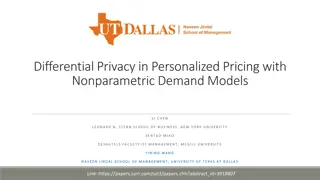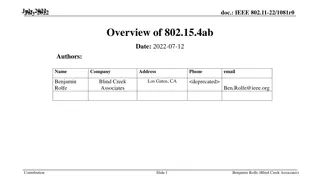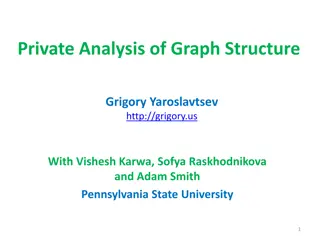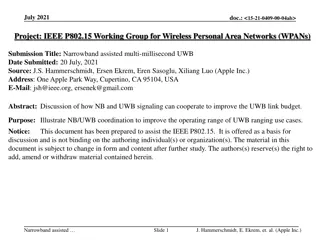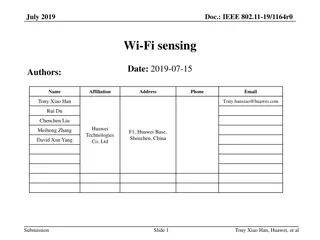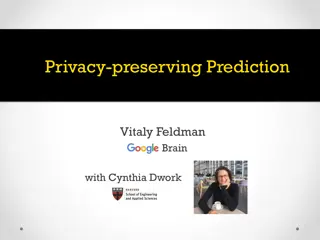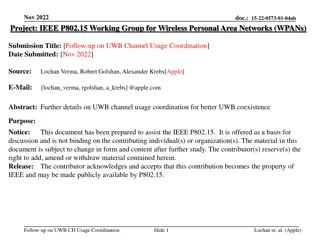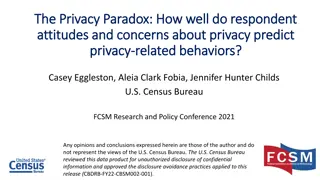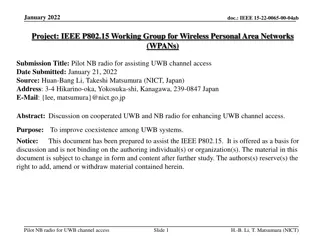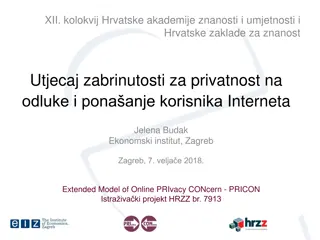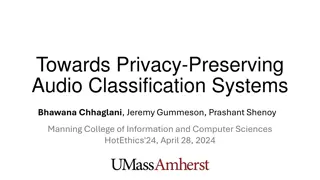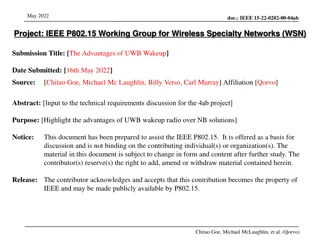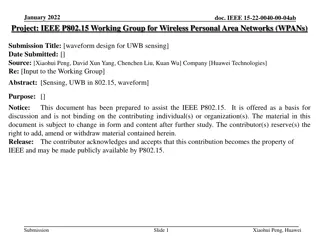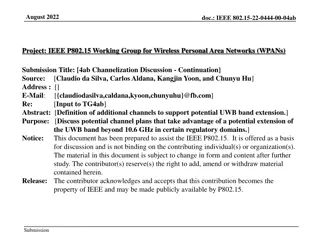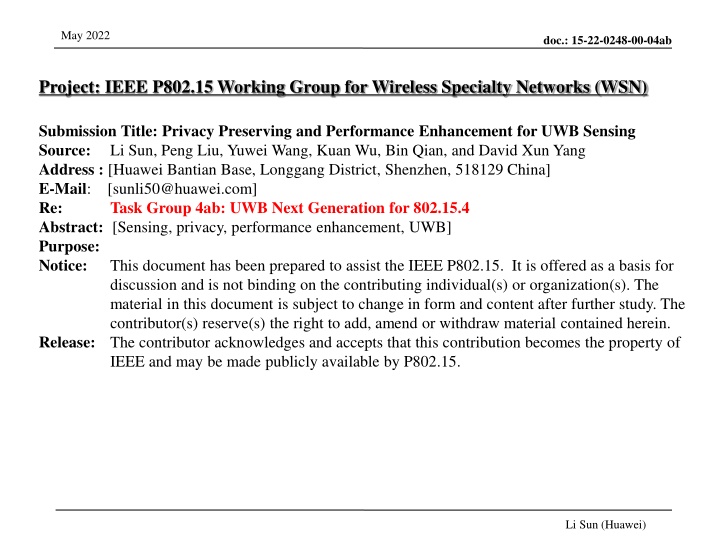
Enhancing UWB Sensing Performance with Privacy Preservation
Explore how collaborative sensing can improve performance and privacy in UWB sensing applications. Addressing privacy concerns and proposing safeguards for high throughput data use cases while supporting interference mitigation techniques and backward compatibility. The document also discusses improvements in accuracy, reliability, and power consumption for enhanced ranging capabilities.
Download Presentation

Please find below an Image/Link to download the presentation.
The content on the website is provided AS IS for your information and personal use only. It may not be sold, licensed, or shared on other websites without obtaining consent from the author. If you encounter any issues during the download, it is possible that the publisher has removed the file from their server.
You are allowed to download the files provided on this website for personal or commercial use, subject to the condition that they are used lawfully. All files are the property of their respective owners.
The content on the website is provided AS IS for your information and personal use only. It may not be sold, licensed, or shared on other websites without obtaining consent from the author.
E N D
Presentation Transcript
May 2022 doc.: 15-22-0248-00-04ab Project: IEEE P802.15 Working Group for Wireless Specialty Networks (WSN) Submission Title: Privacy Preserving and Performance Enhancement for UWB Sensing Source: Li Sun, Peng Liu, Yuwei Wang, Kuan Wu, Bin Qian, and David Xun Yang Address : [Huawei Bantian Base, Longgang District, Shenzhen, 518129 China] E-Mail: [sunli50@huawei.com] Re: Task Group 4ab: UWB Next Generation for 802.15.4 Abstract: [Sensing, privacy, performance enhancement, UWB] Purpose: Notice: This document has been prepared to assist the IEEE P802.15. It is offered as a basis for discussion and is not binding on the contributing individual(s) or organization(s). The material in this document is subject to change in form and content after further study. The contributor(s) reserve(s) the right to add, amend or withdraw material contained herein. Release: The contributor acknowledges and accepts that this contribution becomes the property of IEEE and may be made publicly available by P802.15. Li Sun (Huawei)
May 2022 doc.: 15-22-0248-00-04ab PAR Objective Proposed Solution (how addressed) Safeguards so that the high throughput data use cases will not cause significant disruption to low duty-cycle ranging use cases Interference mitigation techniques to support higher density and higher traffic use cases Other coexistence improvement Backward compatibility with enhanced ranging capable devices (ERDEVs) Improved link budget and/or reduced air-time Additional channels and operating frequencies Improvements to accuracy / precision / reliability and interoperability for high-integrity ranging Reduced complexity and power consumption Hybrid operation with narrowband signaling to assist UWB Enhanced native discovery and connection setup mechanisms Sensing capabilities to support presence detection and environment mapping This contribution proposes a novel sensing mode called collaborative sensing, which can preserve user privacy and improve sensing performance as well. Low-power low-latency streaming Higher data-rate streaming allowing at least 50 Mbit/s of throughput Support for peer-to-peer, peer-to-multi-peer, and station-to- infrastructure protocols Infrastructure synchronization mechanisms Li Sun (Huawei) Slide 2
May 2022 doc.: 15-22-0248-00-04ab Related Contributions UWB sensing in 802.15 <15-21-0399-00-04ab>, Jul. 2021, Frank Leong, et. al. UWB sensing scenarios for 802.15.4ab <15-22-0012-01-04ab>, Jan. 2022, Pooria Pakrooh, et. al. Sensing continued <15-22-0061-00-04ab>, Jan. 2022, Frank Leong, et. al. Sensing device <15-22-0175-00-04ab>, March. 2022, Dag T. Wisland, et al. Privacy issues in UWB sensing <15-22-0177-00-04ab>, Mar. 2022, Li Sun, et al. Li Sun (Huawei) Slide 3
May 2022 doc.: 15-22-0248-00-04ab Privacy Issues in Sensing (Recap) Two privacy issues in UWB sensing have been identified in [1]. Privacy issue #1: CIR report fed back from receiver to transmitter may be overheard by unauthorized or malicious users, which incurs privacy concerns This issue can be easily dealt with using encryption approaches Privacy issue #2: Sensing packets/preamble can be received and decoded by anyone. By capturing legitimate transmitter s sensing packets/preamble and measuring CIR, unauthorized entities can infer the presence and locations of the objects, analyze the behaviors of users, do environmental mapping, etc., which violates users privacy requirement This issue is more challenging than issue #1, because it cannot be solved by simply using encryption techniques. [1] Privacy issues in UWB sensing <15-22-0177-00-04ab>, Mar. 2022, Li Sun, et al. Li Sun (Huawei) Slide 4
May 2022 doc.: 15-22-0248-00-04ab Collaborative Sensing: Framework Basic Idea: Responder2 Responder1 Each sensing round is divided into two slots TX2 TX1 In each slot, two responders transmit sensing packets collaboratively, where the sensing packets are generated from a public sequence and a secret codeword Slot1: +s[n] Slot2: -s[n] Slot1: +s[n] Slot2: +s[n] Object g h The initiator combines the received signals from two slots to produce the sensing result Due to the ignorance of the codewords, the unauthorized users are unable to infer the correct CIRs Initiator RX Round 1 Round 2 ... Slot1 Slot2 Slot1 Slot2 Initialization Sensing Procedure Li Sun (Huawei) Slide 5
May 2022 doc.: 15-22-0248-00-04ab Collaborative Sensing: Implementation Step 1: Initialization and synchronization setup (details will be discussed later) Step 2: Sensing protocol within any round ?: Slot 1: TX1: a?? ? , TX2: b?? ? Slot 2: TX1: c?? ? , TX2: d?? ? s[n] is a public sequence known by everyone (e.g., Ipatov preamble) {{a?, c?}, {b?, d?}} constitutes the codeword used for round m, which is chosen randomly from the following codebook: {{+1,+1},{+1,-1}}, {{+1,-1},{+1,+1}}, {{+1,+1},{-1,+1}}, {{+1,-1},{-1,-1}}, {{-1,+1},{+1,+1}}, {{-1,-1},{+1,-1}}, {{-1,+1},{-1,-1}}, {{-1,-1},{-1,+1}} The codeword indices (i.e., 1~8) used for each round are only shared among the legitimate parties during Step 1 and are unknown to other devices (many approaches can be utilized to realize this, such as encryption) Li Sun (Huawei) Slide 6
May 2022 doc.: 15-22-0248-00-04ab Collaborative Sensing: Implementation Step 3: CIR estimation by joint processing ??,1? = ? ? ?? + ? ? ??? + ??,1[?] ??,2? = ? ? ?? ? ? ??? + ??,2[?] Slot 1: Slot 2: where m is the round index and the codeword is assumed to be {{+1,+1},{+1,-1}}. Here, perfect synchronization is assumed between the two responders (how to realize this will be discussed later) CIR estimate: z1? = ??,1? +??,2? = 2? ? ?? +??,1? + ??,2[?] ?? z2? = ??,1? -??,2? = 2? ? ??? +??,1? ??,2[?] ??? Li Sun (Huawei) Slide 7
May 2022 doc.: 15-22-0248-00-04ab Collaborative Sensing: Implementation Benefits of Collaborative Sensing Privacy preserving capability: Based on the received signals within each round, the unauthorized user is only able to estimate the linear combinations of ?? and ??? , where the combination coefficients are determined by the codewords. Thus, it is very difficult for the unauthorized user to estimate the CIR correctly, thereby protecting user privacy Within any round ?, the received signals at the unauthorized user: ??,?,1? = a?? ? ?,?? + ??? ? ??,?? + ??,?,1[?] a? ?,?? + ????,?? ??,?,2? = ??? ? ?,?? + ??? ? ??,?? + ??,?,2[?] ?? ?,?? + ????,?? The CIRs available at the unauthorized user: a1 ?,1+ ?1??,1,?1 ?,1+ ?1??,1, a2 ?,2+ ?2??,2, ?2 ?,2+ ?2??,2, Li Sun (Huawei) Slide 8
May 2022 doc.: 15-22-0248-00-04ab Collaborative Sensing: Implementation Benefits of Collaborative Sensing Privacy preserving capability: Based on the received signals within each round, the unauthorized user is only able to estimate the linear combinations of ?? and ??? , where the combination coefficients are determined by the codewords. Thus, it is very difficult for the unauthorized user to estimate the CIR correctly, thereby protecting user privacy Improved sensing accuracy: 3dB SNR boost in CIR estimates ?? z1? = ??,1? +??,2? = 2? ? ?? +??,1? + ??,2[?] z2? = ??,1? -??,2? = 2? ? ??? +??,1? ??,2[?] ??? Both ?? and ??? can be estimated, thus obtaining a more accurate and complete characterization of the object being sensed Li Sun (Huawei) Slide 9
May 2022 doc.: 15-22-0248-00-04ab Details of Initialization Step Initiator transmits sensing request Responder 1 & 2 responds to the initiator by sending sensing request confirmation Initiator estimates the round-trip time between the two responders and itself, denoted by TRT1 and TRT2 Initiator broadcasts an activation packet tostart the sensing procedure. The activation packet, sent at ??????, includes the following: Timing information: a fixed delay , TRT1, TRT2 Codeword indices for each round (encryption is applied prior to transmission) Responders determine the time instants to transmit sensing packets: Responder 1: t1+ (t1 is the time inst. at which activation packet is received by resp. 1) Responder 2: t2+ +TRT1-TRT2 (t2is the time inst. at which activation packet is received by resp. 2) The time instant of receiving sensing packet 1 at the initiator: ? = ??????+???1 2 The time instant of receiving sensing packet 2 at the initiator: ? = ??????+???2 2 + + ???1 2 = ??????+ ???1+ + + ???1- ???2 + ???2 2 = ??????+ ???1+ Li Sun (Huawei) Slide 10
May 2022 doc.: 15-22-0248-00-04ab Summary A new sensing paradigm called collaborative sensing is proposed, where two responders perform joint sensing in a collaborative way A coding method is developed at TX sides to pre- process the sensing signals, and a low-complexity signal combining approach is applied at RX side The proposed method prevents the unauthorized users deciphering the CIR from its received sensing packets, thus protecting user privacy Moreover, by using the proposed method, the CIR can be estimated with higher accuracy, and a more complete characterization of the object can be obtained Li Sun (Huawei) Slide 11

